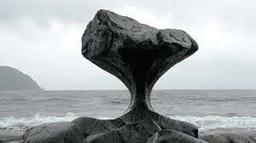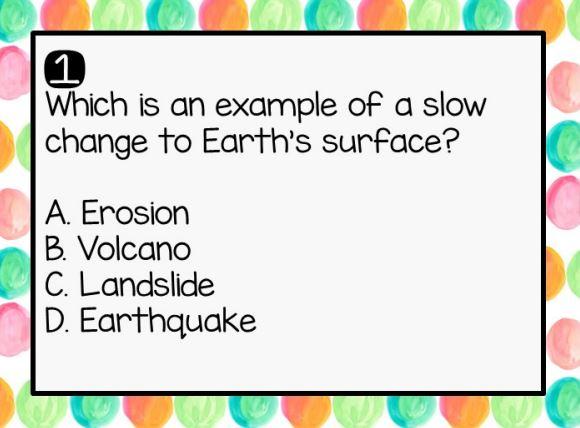
Task Cards Weathering, Erosion, and Deposition
Quiz by Dawn Tate
Grade 4
Science (2021)
Texas Essential Knowledge and Skills (TEKS)
Feel free to use or edit a copy
includes Teacher and Student dashboards
Measures 1 skill from
Measures 1 skill from
Track each student's skills and progress in your Mastery dashboards
With a free account, teachers can
- edit the questions
- save a copy for later
- start a class game
- automatically assign follow-up activities based on students’ scores
- assign as homework
- share a link with colleagues
- print as a bubble sheet
20 questions
Show answers
- Q1Which is an example of a slow change to Earth's surface?D: EarthquakeA: ErosionB: VolcanoC: Landslide30sSCI.4.10B
- Q2The build up of land by the settlement of sediment and soil in a new location is __________.A: weathering.C: glacier.B: erosion.D: deposition.30s
- Q3This is a picture of a canyon. What natural force is responsible for creating this chang to Earth's surface?B: Water movingC: Freezing of iceA: Wind blowingD: Rocks rubbing together30s
- Q4How does ice cause weathering?B: By staying in one spotA: By breaking rocksD: Ice can't cause weatheringC: By carrying sediment30s
- Q5The breakdown of solid materials into smaller pieces by water and other natural events is _________.D: a volcanoA: erosionB: depositionC: weathering30s
- Q6How did the cliff in the picute form?A: Wind hit the rock and weathered it.D: Waves hit the cliff and weathered and eroded the sediments.B: The cliff grew like thatC: Snow eroded the cliff.30s
- Q7How long does it take to see the effects of weathering, erosion, and deposition?A: One dayD: A yearB: Many yearsC: A month30s
- Q8The movement of sediments from one place to another is _____________.C: erosionB: depositionA: weatheringD: an earthquake30s
- Q9How did these sand dunes form?C: Water moved the sandB: An earthquake moved the sandA: Loose sand being blown by the wind.D: A volcano will soon erupt30s
- Q10Small particles of sand, soil, shells, pieces of rocks and minerals, and organic matter deposited by wind, water, or ice is ______________.B: a glacierA: a sand duneD: sedimentC: deposition30s
- Q11What are the four agents of erosion?A: Wind, water, sand, grassC: Gravity, ice, mountains, weatheringB: Water, ice, gravity, mountainsD: Wind, water, ice, gravity30s
- Q12How does a glacier change a mountain?ADCB30s
- Q13The picture shows a delta. Where do deltas form?B: At the mouth of the riverA: At the beginning of the riverD: In the mountainsC: In the middle of the ocean30s
- Q14A delta forms because __________________________.D: there are more trees.A: the river slows down and drops sediments.B: the water changes temperature.C: the water becomes too salty.30s
- Q15Where might you find rocks that are smooth and round?D: In a fast flowing riverB: On a mountain topC: In a glacierA: In a volcano30s
